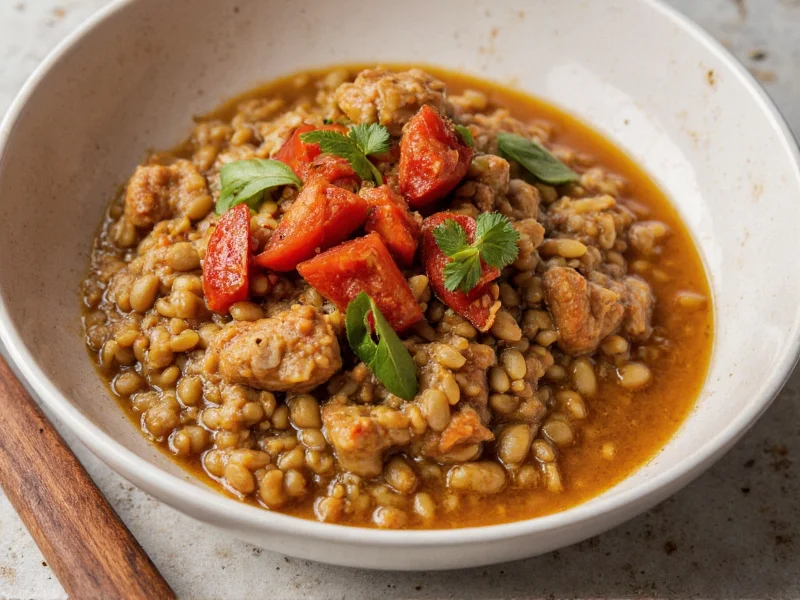The Nutritional Powerhouse: What Makes Lentils Healthy
Lentils stand among the most nutritionally complete plant foods available. Unlike many plant proteins, lentils offer a relatively complete amino acid profile when paired with grains. Their impressive nutritional composition explains why health organizations worldwide recommend regular legume consumption.
| Nutrient | Per 1 Cup Cooked (198g) | % Daily Value |
|---|---|---|
| Calories | 230 | 12% |
| Protein | 18g | 36% |
| Fiber | 15g | 54% |
| Folate | 358mcg | 90% |
| Iron | 6.6mg | 37% |
| Manganese | 1.3mg | 57% |
Science-Backed Health Benefits of Lentils
Multiple longitudinal studies demonstrate lentils' positive impact on human health. The Journal of Nutrition published research showing regular lentil consumption correlates with 21% lower risk of developing type 2 diabetes. This effect stems from lentils' low glycemic index (around 30) and high fiber content, which slows glucose absorption.
Heart Health Protection
Lentils significantly improve cardiovascular markers. Their soluble fiber binds to cholesterol in the digestive system, preventing absorption. A comprehensive review in Advances in Nutrition concluded that eating one daily serving of legumes reduces LDL cholesterol by approximately 5%. The potassium and magnesium in lentils also help regulate blood pressure.
Digestive Wellness and Gut Microbiome
The substantial fiber content in lentils (15g per cup) serves as prebiotic fuel for beneficial gut bacteria. Research in Nutrients journal shows lentil consumption increases butyrate production, a short-chain fatty acid that reduces intestinal inflammation and strengthens the gut barrier. This makes lentils particularly valuable for managing digestive health.
Weight Management Support
For those asking are lentils good for weight loss, evidence suggests yes. Lentils' protein-fiber combination creates exceptional satiety. A study in Obesity found participants consuming lentil-based meals reported 31% greater fullness and ate 13% fewer calories at subsequent meals compared to refined carbohydrate meals.
Addressing Common Concerns About Lentils
Some people experience digestive discomfort when first incorporating lentils. This typically resolves as the gut microbiome adapts. Soaking dried lentils for several hours before cooking reduces oligosaccharides that cause gas. Those with irritable bowel syndrome may benefit from starting with smaller portions of red lentils, which are easier to digest than green or brown varieties.
Contrary to concerns about are lentils inflammatory, research indicates lentils have anti-inflammatory properties. Their polyphenol content, particularly flavonoids, reduces inflammatory markers like C-reactive protein according to a British Journal of Nutrition study.
Optimal Preparation for Maximum Nutrition
To preserve nutrients while eliminating anti-nutrients:
- Rinse thoroughly before cooking
- Soak dried lentils for 2-4 hours (reduces cooking time and improves digestibility)
- Cook in fresh water (don't use soaking water)
- Add acidic ingredients like tomatoes after cooking (preserves folate)
For how to cook lentils for maximum nutrition, avoid overcooking. Simmer until tender but still holding shape (15-25 minutes depending on variety). Pressure cooking preserves more nutrients than boiling for extended periods.
Lentils in Specialized Diets
For diabetics: Lentils' low glycemic index makes them excellent for blood sugar control. The American Journal of Clinical Nutrition reported lentil consumption reduced post-meal glucose spikes by 20-35% compared to equivalent carbohydrate servings from refined grains.
Vegan and vegetarian diets: Combine lentils with grains like rice for complete protein. One cup of cooked lentils plus half cup brown rice provides all nine essential amino acids.
Lentils vs beans nutrition: While both are nutritious, lentils generally cook faster without soaking and contain slightly more folate and iron than many beans. Black beans have comparable fiber, while chickpeas contain less iron.
Evidence-Based Recommendations
Nutrition scientists recommend consuming legumes like lentils at least 3-4 times weekly. The Dietary Guidelines for Americans specifically identifies lentils as a nutrient-dense food that helps meet vegetable and protein group recommendations simultaneously. For optimal health benefits, replace refined carbohydrates with lentils rather than simply adding them to existing diets.
Conclusion: Lentils as a Nutritional Cornerstone
Lentils represent one of nature's most complete functional foods. Their exceptional nutrient density, proven health benefits, and culinary versatility make them worthy of regular inclusion in balanced diets. While not a miracle food, the scientific consensus confirms lentils contribute significantly to long-term health when consumed as part of varied eating patterns. Whether you're concerned about heart health, blood sugar management, or simply seeking nutrient-rich plant foods, lentils deliver measurable benefits supported by decades of nutritional research.











 浙公网安备
33010002000092号
浙公网安备
33010002000092号 浙B2-20120091-4
浙B2-20120091-4